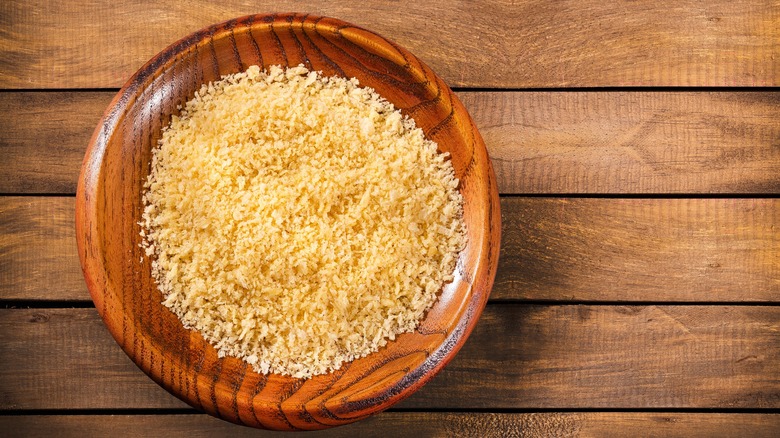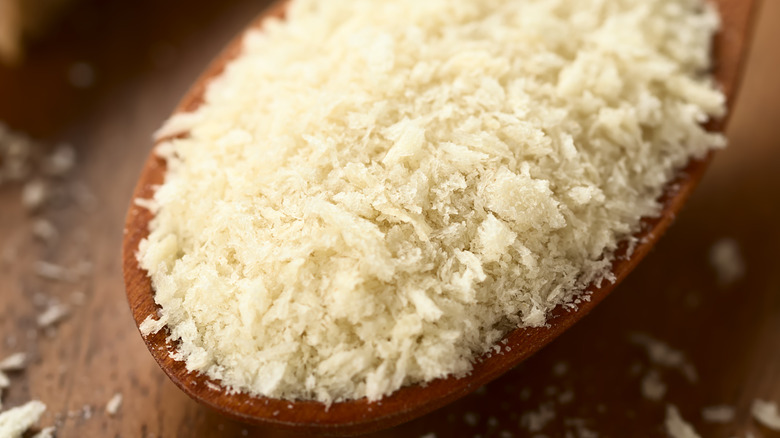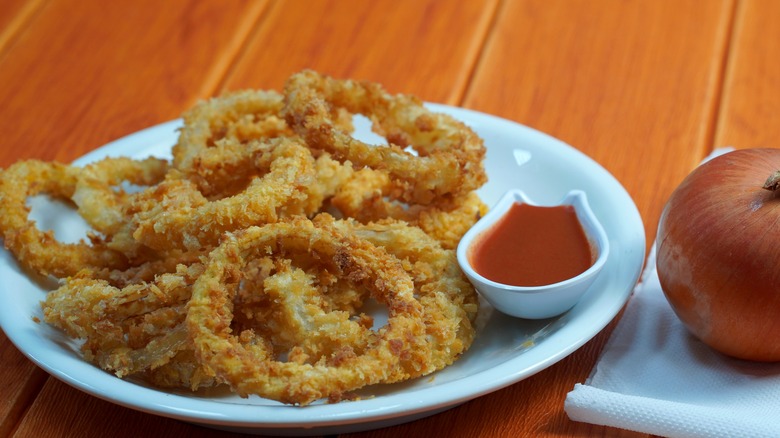The Breadcrumb Swap You Need To Make For Maximum Crunch
Breadcrumbs are used in so many recipes. You can use them as a coating for foods or a topping to add flavor and crunch, elevating dishes like macaroni and cheese. Sure, breadcrumbs are easy to make using day-old bread that's been run through a food processor, but pre-made breadcrumbs are a lot more convenient when you're in a hurry to get dinner on the table.
While traditional breadcrumbs add some crunch to a dish, they often lose their crispness after cooking. But there's a substitute you can use that's better than conventional store-bought breadcrumbs.
The secret to getting the biggest crunch for your buck lies in using a hearty crumb that can stand up to liquids like oil and batter and withstand high temperatures and long cooking times. The swap you need to make to get the maximum crunch in your recipes is what Bon Appetit refers to as "crispy, airy, Japanese miracles."
The magic of panko
What's the one thing you can add to your recipes to maximize crispiness? The answer is using a special type of breadcrumb known as panko. Panko — from the words "pan" (an old Portuguese word meaning "bread") and "ko" ("flour" or "crumb" in Japanese), per Kingston Cove Studio — are also known as Japanese breadcrumbs because they are commonly used in Japanese cooking. Panko crumbs consist of bigger, differently shaped granules than traditional breadcrumbs. They can make all the difference in your recipes.
According to MasterClass, panko crumbs can replicate the taste of fried foods without frying. You can coat food in panko, bake it in the oven, and have a dish that delivers the crunch of fried food without oil. If you choose to fry your food, there's still a benefit to using panko. The crunchy panko crumbs absorb less oil than regular breadcrumbs, making the dish healthier, or at least a little less unhealthy,
You might think a specialty breadcrumb like panko would be more expensive than standard breadcrumbs, but that's not necessarily true. Ounce for ounce, popular brand 4C Foods panko crumbs generally cost the same as regular crumbs (via Wegmans). That means you can get a lot of crunch without crunching your budget!
A fascinating origin
Panko breadcrumbs have a fascinating history. Rumors on the internet claim that during World War II, the Japanese would bake bread using the batteries of army tanks, since they didn't have any other way to do the job. In doing so, they allegedly discovered that bread baked using the electricity of the tank battery created a distinctive lightness in the loaf and a crust that would break into slivers when cut. Great story, but it's not entirely true.
The Japanese had been experimenting with cooking with electric current for over ten years before WWII even began. In 1933, the Japanese army commissioned an inventor to develop a field kitchen that employed electroconductive heating for troops at the front lines. They discovered the method created a "light, yeasty, crust-free bread" (per Recipes Hypotheses). Today, panko is made the same way, using an electric current to give them the unique flakey texture that delivers the crunch.
Using panko breadcrumbs to coat onion rings guarantees a crispness you can't achieve with regular breadcrumbs. Impress your dinner guests with crunchy panko-crusted hearts of palm cakes, or try this recipe for French Toast Sticks that uses panko as a coating, and you'll see what we mean. There are gluten-free panko breadcrumbs if you cook sans gluten. Plus, plain panko is free of all seasonings, including dairy products, allowing you to accommodate all dietary preferences and giving you the freedom to add whatever you'd like to cook the crunchy creation of your dreams.


